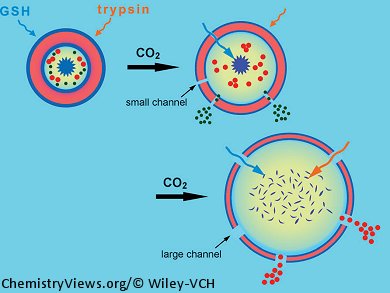A team of scientists in China have developed a method for adjusting the permeability of polymersome membranes by using CO2-responsive copolymers. Jinying Yuan and co-workers, Tsinghua University and China Women’s University, used atom transfer radical polymerization to synthesize amphiphilic block copolymers comprising a hydrophilic poly(ethylene glycol) section and a hydrophobic poly(N-amidino)dodecyl acrylamide section. The resulting polymers self-assemble into vesicular nanostructures in aqueous solution. As the hydrophobic section is CO2-responsive, the polymersomes expand in the presence of CO2, and collapse when it is removed.
The researchers then showed how the membrane permeability of the polymersomes could be tuned by loading them with dye-labeled nanoparticles of two different sizes. The smaller nanoparticles were released after bubbling CO2 through the solution for 10 minutes, whereas the larger particles were released only after 30 minutes of exposure to CO2, when the wall thickness was lowest and the pore size highest.
Finally, the polymersomes were used to investigate biochemical reaction compartmentalization. The cells were loaded with myoglobin as an enzyme model. Glutathione (GSH) was added to the solution but reacted with the encapsulated myoglobin only after the solution was bubbled with CO2 for 5 minutes and the vesicles were expanded. In contrast, 15 minutes of CO2 exposure was required to expand the vesicles further so that the bulkier trypsin could enter. These tunable polymersomes will thus be useful in mimicking cytomembranes and further understanding cellular functions.
- Breathing Polymersomes: CO2-Tuning Membrane Permeability for Size-Selective Release, Separation, and Reaction,
Qiang Yan, Jianbo Wang, Yingwu Yin, Jinying Yuan,
Angew. Chem. Int. Ed. 2013.
DOI: 10.1002/anie.201300397

